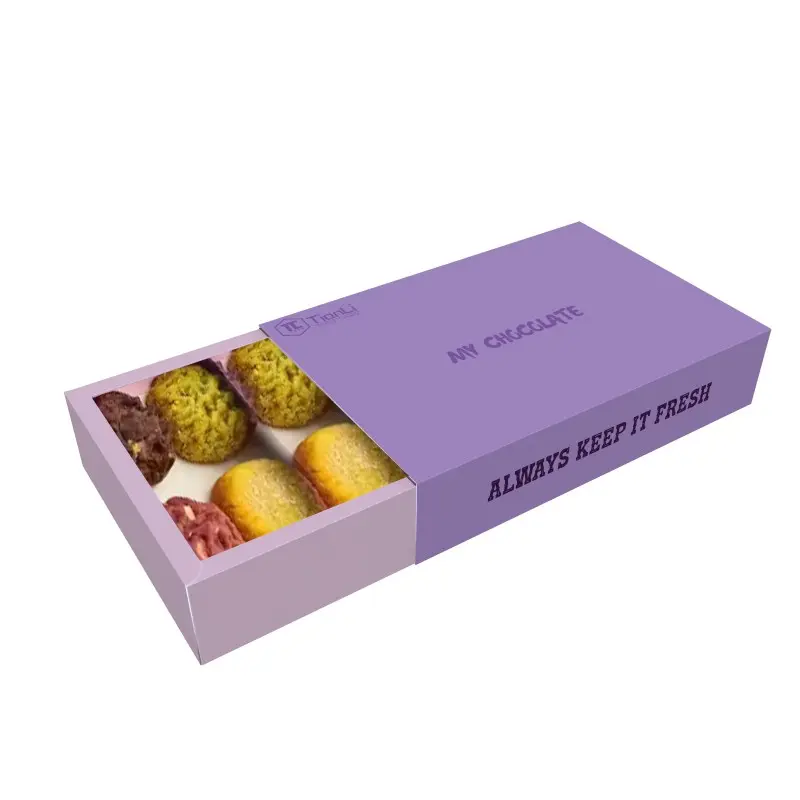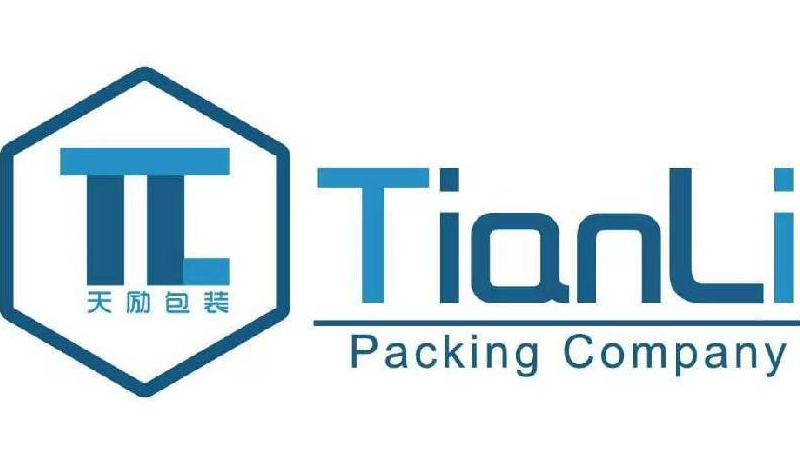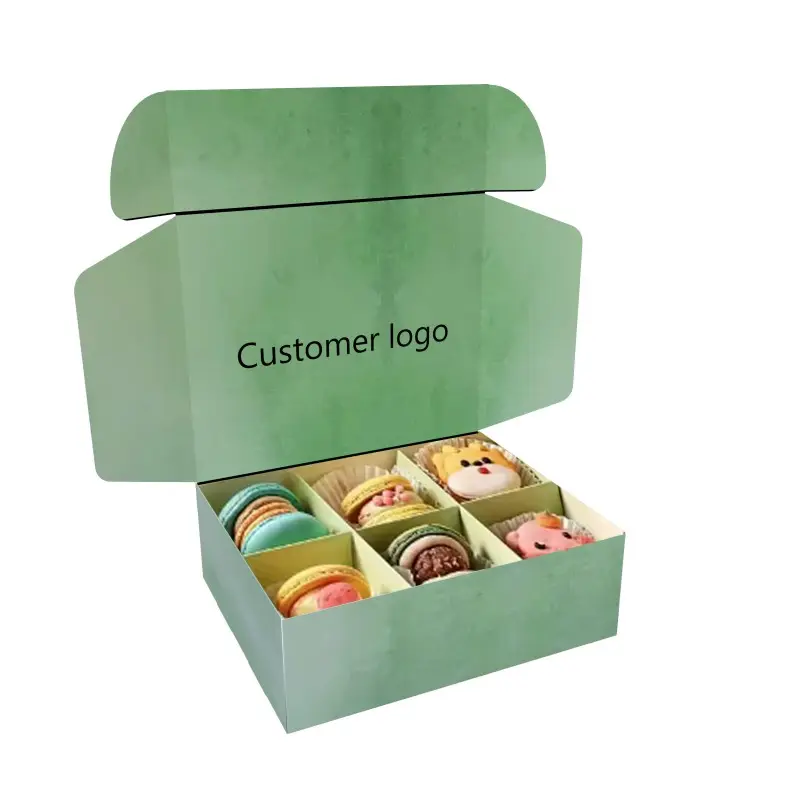Изборът на правилното Кутия за храна Производствен партньор
Оценка на експертизата в Храна -качествени материали
Изборът на правилния производител за кутии за храна започва с това, колко добре те познават материалите, подходящи за контакт с храна. Наистина важно е не само да се знае разликата между хартия, пластмаса и биоразградимите алтернативи, но и да се разбере кой материал е най-подходящ за реални условия. Човек, който е работил обстойно с тези материали, знае точно какво е необходимо, за да се отговаря на изискванията на FDA и другите стандарти за безопасност на храните, които гарантират защита на продуктите по време на транспортиране и съхраняване. Искате доказателства? Помолете да видите реални примери или поговорете с предишни клиенти, които са имали подобни предизвикателства при нуждите си от опаковки. Отзивите от практиката говорят много за това дали една компания може да се справи с конкретни поръчки, без да компрометира стандартите за безопасност, които защитават както потребителите, така и репутацията на марката.
Оценка на ангажиментите към устойчивостта
При избор на производствен партньор, много значение има неговите екологични качества. Първо вижте какво става зад кулисите на техните доставки. Как всъщност те получават тези устойчиви материали? Какви стъпки предприемат, за да намалят емисиите? Също така съществуват сертификати – етикети FSC или статус ISO 14001, които показват сериозни усилия за еко-пакетиране. Не забравяйте да проверите дали техните дългосрочни цели съвпадат с тези на вашия бизнес, когато става въпрос за опазване на планетата. Партньорство, изградено върху споделени екологични ценности, не само че е морално правилно, но действително помага на двете страни да сътрудничат по-ефективно при намаляването на общите въглеродни емисии с течение на времето.
Преглед на сертификати (напр. FDA, BRC)
Получаването на правилните сертификати е наистина важно, когато става въпрос за спазване на правилата за безопасност на храните, затова компаниите трябва да проверят какви сертификати са задължителни за техните опаковъчни материали. Най-важните от тях са одобренията на FDA и сертификатите на BRC от Британската ретайлна консорция. Тези сертификати не са просто формалност – те показват, че компанията отговаря на определени стандарти за качество в различни пазарни сегменти. Когато избирате доставчици, не забравяйте да поискате копия от всички техни сертификати и отделете време да ги прегледате внимателно. Това помага да се потвърди дали производителят е легитимен. Освен това, наличието на правилните сертификати изгражда доверие у клиентите, които искат гаранти, че продуктите, които купуват, няма да предизвикат здравни проблеми в бъдеще. Заинтересованите страни също ще оценят тези документи, тъй като те демонстрират отговорност през цялата верига на доставки.
Ефективни комуникационни стратегии
Задаване на изискванията за дизайн от самото начало
Започвате ли проект за опаковане, осигурете си спецификациите за дизайн още от първия ден. Зная точно какви трябва да бъдат размерите, кои цветове се комбинират най-добре и къде трябва да се намират логата на марката. Тази основна информация предотвратява объркване и недоразумения между участниците по-късно. Добра скица или примерна снимка също много помага, когато обяснявате идеи пред други, които може да нямат същото визия. И като стана дума за това, не чакайте проблемите да се появят чак по време на производството, за да ги споменете. Обсъдете възможните проблеми от самото начало с доставчиците и производителите. Видяхме прекалено много проекти, които срещнаха пречки просто защото някой е предположил, че нещо ще работи, но никой не е проверил дали наистина може.
Съгласуване на предпочитанията и ограниченията относно материалите
Когато започнем да обсъждаме какви материали искаме още в началото, това прави голяма разлика при работа с нашия доставчик на опаковки. Ако някой иска нещо еко-приятелско, като например рециклиран картон или биоразградими пластмаси, важно е това да се изкаже ясно, за да се осигури, че направеното наистина ще отговаря на изискванията на продукта. Не забравяйте да споменете и евентуални недостатъци – някои зелени алтернативи просто не издържат толкова добре с течение на времето или по време на транспортиране. Също така е важно всички да са наясно какви материали са на разположение точно сега, защото закъсненията в производството са чести. Доставните вериги днес са доста сложни, така че предварителното знание за евентуални проблеми ще спести главоболия по-късно.
Определяне на ясни очаквания за стандартите за безопасност на храните
При създаването на опаковка за хранителни продукти, изготвянето на ясни насоки относно стандартите за безопасност става наистина важно. Опаковката трябва да отговаря на определени изисквания, за да се съобразява със законовите изисквания. Важно е също да се огледа колко добре производителите спазват тези правила. Техният стаж с проверки за качество показва дали те могат постоянно да произвеждат безопасни продукти. Проверката на тези параметри за безопасност по време на реалното производство не е просто добра практика – тя е практически задължителна, за да се поддържа гладкото функциониране. Повечето компании установяват, че редовни прегледи помагат да се засичат евентуални проблеми, преди те да се превърнат в реални проблеми.
Управление на производството и контрола на качеството
Значение на прототипирането и пробното производство
Прототипирането играе важна роля в производството, тъй като ни дава възможност да тестваме различни материали и да проверим дали нашите дизайнерски решения работят, преди да се ангажираме с масово производство. Когато изработваме прототипи, можем да видим кои материали наистина отговарят на очакванията и да отбележим евентуални промени, които ще подобрят функционалността. За да се уверим, че крайният продукт отговаря на изискванията за качество и е безопасен, извършвам подробни тестове още докато се правят пробите. Подлагаме прототипите на изпитания в много различни ситуации, които приличат на реалните условия на употреба. Обратната връзка от тези тестове също прави голяма разлика – тя ни показва къде да направим корекции и да отстраним проблеми, така че крайният продукт да отговаря на всички изисквания.
Внедряване на протоколи за осигуряване на качеството
Добрите мерки за контрол на качеството са от голямо значение, когато става въпрос да се поддържа гладко функциониране по време на производството. Нашите доставчици добре знаят това, защото спазването на строги насоки означава, че всяка серия, произведена на линията, изглежда и работи по точно същия начин. Ние извършваме редовни проверки и обиколки на различни етапи, за да се уверим, че всичко отговаря на стандартите, които сме задали. Тези рутинни посещения разкриват проблеми преди те да се превърнат в сериозни затруднения по-късно и ни дават реални числа, с които да работим при извършване на подобрения. Внедряването на технологични решения като автоматични системи за инспекция наистина помага да се ускори процесът, като същото време се постигат по-добри резултати. Машините не се уморяват или разсейват, така че забелязват дефекти по-бързо, отколкото хората някога биха могли. Освен това, цялата тази автоматизация спестява време общо взето, без да компрометира качеството на крайните продукти.
Следене на производствени графици
Създаването на стабилен график на производството с ясно обозначени етапни точки прави голяма разлика при управлението на проекти и поддържането на нещата навременно. Когато тези етапи са правилно зададени, става много по-лесно да се следи какво е положението и да се забелязват проблеми, преди те да излязат извън контрол. Важно е също да се предвиждат евентуални закъснения. Готовите планове за резервни мерки дават на екипите шанс да се справят с неочакваните ситуации. Седмичните срещи с производствения екип помагат на всички да са в синхрон относно това какво работи, а какво трябва да се коригтира, като същевременно се следи за спазване на сроковете. Не трябва да се пренебрегва и връзката с партньорите. Поддържането на отворени канали за комуникация между отделите позволява бързи решения, когато се появят препятствия – нещо, което научихме по трудния начин по време на пускането на продукта през последното тримесечие.
Управление на логистиката и изискванията за поръчки
Провеждане на преговори за минимални поръчани количества (MOQs)
Когато става въпрос за опаковка на хранителни продукти, минималното количество за поръчка (MOQ) е от голямо значение, защото влияе на това колко компанията ще плати за единица продукт и как ще планира поръчките си. Като цяло, поръчването на по-големи количества води до по-ниска цена на единица продукт, благодарение на отстъпките за количество, което от своя страна влияе на начина, по който търговците определят цените. Но има една особеност – някои доставчици всъщност предоставят възможност за преговори по тези изисквания за MOQ, в зависимост от това какво е подходящо за различните бизнеси. Всъщност малките пекарни или специализираните магазини често се нуждаят от по-малки серии в сравнение с големите вериги. Регулирането на MOQ помага на компаниите да поддържат нивата на наличностите си точно там, където трябва да бъдат, без да закупуват повече от необходимото. Това става особено важно по време на празнични сезони, когато търсенето рязко нараства, или когато непредвидени събития наруша нормалните модели на предлагане на пазара.
Оптимизиране на опаковката за ефективност при транспортирането
Подобрването на процесите за транспортиране всъщност се свежда до избора на подходящи дизайни на опаковки, които да осигуряват продуктите, но също така да използват ефективно пространството и да намалят разходите. Вземете например сгъваемите кашони – те всъщност позволяват на компаниите да натоварват повече стоки в камиони и самолети, защото заемат по-малко място, когато са празни. И нека не забравяме за опаковките с екологични материали като вторичен картон или биоразградими пластмаси, които помагат за постигане на целите за устойчивост, без да поставят под риск продуктите. За производителите, които се опитват да намалят въглеродния си следа напоследък, намирането на баланс между защита, спестявания и екологична отговорност е станало абсолютно необходимо, за да останат конкурентоспособни в днешния пазар.
Създаване на планове за извънредни ситуации
Доброто планиране по извънредните ситуации прави голяма разлика, когато се имат предвид онези досадни проблеми с логистиката, с които всички сме добре запознати – например закъснения в превоза поради лоши метеорологични условия или непредвидени прекъсвания в доставките. Поддържането на всички в течение чрез надеждни комуникационни канали наистина помага да се ограничи хаосът, когато нещата се объркат. Вземете например компании, които наистина са успели да осъществят операциите си въпреки сериозни неуспехи благодарение на умни резервни планове. Например, някои производители са поддържали производството през периодите на недостиг по време на пандемията, просто защото са имали алтернативни доставчици, подготвени предварително. Основният извод? Компаниите трябва да са гъвкави и готови да променят подхода си, когато се изправят пред логистични кошмари, ако искат да поддържат операциите си гладки и клиентите си доволни, независимо какво се случва извън техните стени.

Изграждане на дългосрочни партньорски взаимоотношения
Поддържане на прозрачни комуникационни канали
Ясната комуникация остава от съществено значение за изграждането на доверие и решаването на проблемите, преди те да се влошат. Когато екипите поддържат отворен диалог, те сътрудничат по-ефективно и решават въпросите далеч по-бързо, отколкото когато всеки запазва нещата за себе си. Съвременните технологични инструменти позволяват на компаниите да изпращат незабавни актуализации и да събират обратна връзка от клиентите без затруднения, така че всички да са в течение на това какво предстои да се направи. Компаниите, които споделят честно целите и препятствията си, обикновено създават среди, където хората действително сътрудничат, вместо просто формално да изпълняват задължения. Този вид откровеност изгражда истински взаимоотношения между партньорите, които продължават дълго след първоначалните договори.
Осигуряване на конструктивни обратни връзки
Наличието на някаква организирана система за даване на обратна връзка наистина помага за напредък и поддържа по-доброто сътрудничество между всички. Когато компании създадат такива системи за обратна връзка, хората от двете страни могат да споделят какво работи добре и къде има възможности за подобрение. Видели сме как това действа на практика прекалено много пъти, за да ги броя. Вземете например производството – когато работниците могат отворено да коментират как работят машините от ден на ден, често това води до реални подобрения в производството. Цялата идея е да се създаде пространство, където всеки участник се чувства комфортно да споделя идеи. Този вид отворена комуникация не само че прави операциите по-плавни, но всъщност предизвиква нови идеи, за които никой иначе нямаше да се сети. Повечето успешни бизнеси вече знаят това и влагат механизми за обратна връзка директно в ежедневните си процеси, защото това носи ползи по множество начини.
Съгласуване на целите за непрекъснато подобрение
Когато компании поставят общи цели за подобрение заедно, те обикновено постигат напредък в качеството на продукта, както и в ефективността на операциите. Редовният преглед на показателите за представяне помага да се следи прогресът към тези съвместни цели и осигурява, че всички участници са наясно какви са следващите стъпки. Иновациите възникват, когато екипите адаптират подходите си след анализ на представянето си в сравнение с това, което се случва в индустрията в момента. Това помага на компаниите да останат пред кривата, вместо да изостават след промените на пазара. Когато всички се насочят към непрекъснато подобрение, това също изгражда по-силни работни взаимоотношения, което води до по-дълготрайни партньорства и реални резултати в дългосрочен план.
Често задавани въпроси
Какви фактори трябва да имам предвид при избор на партньор за производство на кутии за храна?
Вземете предвид фактори като експертиза в използването на хранителни материали, ангажамент към устойчивост и индустриални сертификати като FDA и BRC.
Защо ангажиментите за устойчиво развитие са важни при избора на производствен партньор?
Ангажиментите за устойчиво развитие гарантират, че практиките на партньора съответстват на вашите еко-цели, намалявайки въглеродния след и използвайки устойчиви материали.
Как може да се оптимизира комуникацията с партньор за опаковки?
Оптимизирайте комуникацията, като посочите изискванията за дизайн от самото начало, съгласувате предпочитанията за материали и зададете ясни очаквания относно стандартите за безопасност на храните.
Каква роля играе създаването на прототипи в процеса на производство на опаковки?
Създаването на прототипи позволява тестване на избора на материали и дизайнерските решения, осигурявайки качество и идентифициране на модификации преди пълномащабно производство.
Как компании могат ефективно да управляват предизвикателствата в логистиката?
Чрез договаряне на гъвкави минимални поръчани количества, оптимизация на опаковката за по-ефективна доставка и изготвяне на планове за действие при евентуални нарушения.
Съдържание
- Ефективни комуникационни стратегии
- Управление на производството и контрола на качеството
- Управление на логистиката и изискванията за поръчки
- Изграждане на дългосрочни партньорски взаимоотношения
-
Често задавани въпроси
- Какви фактори трябва да имам предвид при избор на партньор за производство на кутии за храна?
- Защо ангажиментите за устойчиво развитие са важни при избора на производствен партньор?
- Как може да се оптимизира комуникацията с партньор за опаковки?
- Каква роля играе създаването на прототипи в процеса на производство на опаковки?
- Как компании могат ефективно да управляват предизвикателствата в логистиката?

